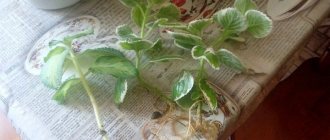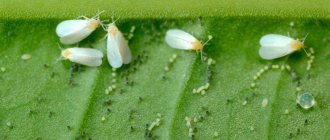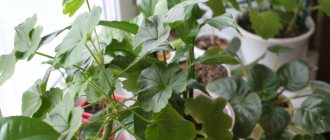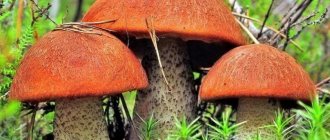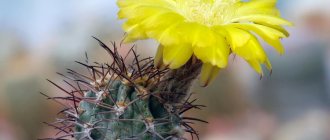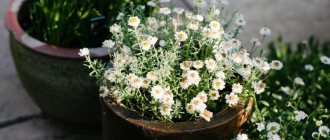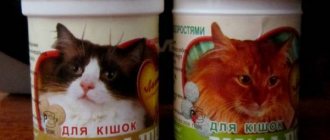Author of the article
Daria Vorontsova
Reading time: 11 minutes
AA
Mint is not only a spice with a rich, fresh aroma, but also a crop that is beneficial for the human body. When added to teas and dishes, it normalizes the emotional state, calms the nervous system, and relieves insomnia. As a spice, it imparts an amazing, illuminating flavor to food.
The culture belongs to the garden, but many are interested in how to grow mint at home in order to receive a harvest of fragrant leaves all year round. At home in a pot, mint takes root well; with proper care, it grows actively even in winter. In order for the plant to be happy with the harvest, you must follow the rules of planting and care.
Mint varieties for growing on a windowsill
In apartment conditions, the same varieties and varieties are suitable for growing as for open ground.
Popular varieties include:
- Pepper;
- Feline;
- Curly;
- Home;
- Menthol;
- Lemon;
- Chocolate.
When talking about which variety of mint is best to grow on a windowsill, you need to take into account the dimensions of the chosen location, the height and spreading nature of the adult plant. It is better to choose varieties that are characterized by small roots and a compact above-ground part:
| Variety | Description |
| "Ceremony" | A small bush with deep green leaves. Rich in menthol, has a deep aroma. Excellent for culinary purposes. |
| "Fun" | Shade-tolerant variety. The bush does not exceed 50 cm in height. The taste of the leaves is fresh, menthol. |
| "Pennyroyal" | Compact bush with small purple-green leaves. The aroma is intense. Used for making cocktails and other drinks. |
| "Spearmint" | Low (35-60 cm). It has oval dark green leaves. The aroma is strong and cooling. Ideal for meat dishes and salads. |
If room conditions allow, you can grow larger varieties: Menthol, Moskvichka, Pepper Garden.
Conditions for keeping
To understand what conditions are necessary for indoor mint, you should remember what region it comes from. The South African native prefers warmth, plenty of light and high humidity. It is better to make the lighting diffused, but at the same time bright. Leaves should not be exposed to direct sunlight, as this can cause burns.
Mint feels best on the southwest side. Comfortable temperature for a flower is +20–24 °C in summer, at +15–16 °C in winter. The plant does not make any special demands on the level of humidity. It is better if it is above 50–60%.
Features of growing mint on the window
Growing mint on a windowsill does not require effort or special skills. You can grow indoor spices throughout the year, but it is advisable to plant them in the autumn or spring months.
The optimal place for summer keeping is a balcony, for winter – a window sill, where there is good lighting. Depending on the size of the bush, it can be placed on a shelf or on the floor. It is advisable to water from a tray with slightly warm boiled water. The leaves are periodically sprayed and cleaned of dust accumulations: this helps to enhance the aroma.
In winter, the plant is dormant and grows slowly. It must be protected from cold and drafts. During the warm period, when growth processes are activated, the upper leaves should be cut off, leaving 2 cm of petiole from the stem: this is necessary to stimulate the appearance of lateral shoots.
How to use homemade mint in folk medicine
The use of fragrant spur flower is practiced in home medicine. The anti-inflammatory, analgesic and strengthening properties of the plant have a positive effect on the body for many ailments.
For enuresis
The benefits and harms of decorative indoor mint allow the plant to be used for enuresis in children and adults. An infusion is prepared based on the spur flower, which is then added to healing baths. The algorithm looks like this:
- Dry or fresh plectranthus leaves are crushed in the volume of a glass.
- Pour the raw material with 500 ml of hot water.
- Leave covered for 45 minutes.
- Strain and pour the product into a filled bathing container.
It is necessary to take such a bath for half an hour shortly before bedtime. The water temperature should only be about 30 °C. Baths are taken daily or every other day until the condition improves. The procedures not only help get rid of enuresis, but also increase skin tone.
The infusion of indoor mint does not last long, so it should be prepared anew every day.
When coughing
The healing properties of aromatic plectranthus improve expectoration during colds and help relieve coughs. Traditional medicine recommends preparing the following remedy:
- About 10 g of dried leaves of the plant are poured into the teapot.
- Pour 300 ml of hot liquid into the raw material.
- Cover with a lid and leave for 15 minutes to infuse.
- Strain through a strainer and pour into cups.
You can drink medicinal tea 2-3 times a day on a full stomach.
Advice! If desired, plectranthus leaves can be mixed in equal volumes with regular tea leaves.
For psoriasis
Indoor mint copes well with skin irritations and has a beneficial effect on psoriasis, eczema and other diseases. It is recommended to use a simple infusion of an ornamental plant. They do it like this:
- Grind clean fresh leaves in the volume of half a glass.
- Brew the raw material in 1 liter of boiling water.
- Leave the infusion in a closed container for a couple of hours.
- After time, filter.
In the finished product, you need to moisten a clean cloth or gauze and treat the affected areas of the skin. It is allowed to wipe the epidermis 4-5 times a day. The infusion has a good effect on diaper rash in children and bedsores in the elderly.
For insect bites
Itching, burning and pain from insect bites are well relieved by fresh plectranthus juice. The plant is used as follows:
- Several leaf blades of the spur flower are thoroughly ground to a paste.
- Squeeze the raw material through cheesecloth to obtain pure juice.
- Soak a cotton pad in the liquid.
We recommend reading: Beneficial properties of Anzura (Suvorov) onion-garlic and contraindications
The juice is applied to the bite sites several times a day. The product can also be used to wipe inflamed wounds and cuts.
Growing mint from seeds
Propagation by seed is the most difficult method. But this method is necessary if you need mint of a specific variety. It is advisable to use purchased seeds. When breeding from independently collected seeds, varietal genes are not always inherited. Below is a step-by-step description of the seed method of planting mint on a windowsill:
- The procedure is carried out in March or April.
- The seeds are immersed 5 mm in moistened soil and covered with a thin layer of peat.
- The pot is covered with glass or polyethylene.
- Do not allow the soil to become waterlogged or dry out. The surface soil layer is sprayed if necessary. Periodically move the glass so that the soil does not rot.
- Seedlings appear on days 15-18. When development reaches the stage of two true leaves, young greenery is planted in separate containers.
Reproduction methods
It is not difficult to propagate homemade mint plectranthus; the main thing is to follow the sequence of steps and do everything carefully so as not to damage the plant.
Cuttings
In winter or spring, the plant is pruned. This is necessary to create the shape of the plant, get rid of weak stems, and remove old leaves. At this time, you can prepare the shoots for transplantation.
Sequence of actions when propagating by cuttings:
- Shoots with at least three buds are harvested;
- Drainage and prepared soil are poured into the pots. It is necessary to disinfect and moisten it in advance;
- The cuttings are placed in the soil, making small holes with a pencil. You can plant several shoots in one pot, then the bush will turn out more lush;
- Water young plants as the top layer of soil dries.
Rooting in water
After 1-2 weeks, the plant usually develops roots. This is evidenced by new leaves growing on the stem. You can also root cuttings in water or sand.
Dividing the bush
Reproduction by dividing the bush is carried out during plant transplantation. After the flower is removed from the pot, carefully shake off the roots and cut with a sharp knife
It is important to disinfect it in advance to prevent infection of the plant.
The cut sites are processed:
- ash;
- activated carbon powder.
New plants are placed in a pot and the free spaces are filled with soil. Before planting, moisten the soil.
Growing mint by root layering
The long, spreading roots of mint have dormant buds. Therefore, the plant can be propagated through root layering. Below are the instructions:
- At the end of summer, root cuttings up to 12 cm long, having 2-3 buds, are taken.
- They are immersed in moist soil to a depth of 5-6 cm.
- If the buds on the root have already awakened and sent out shoots, then the above-ground parts after planting are cut off approximately 5 cm from the top.
- The buds wake up and sprout on average 2 weeks after planting.
The magical properties of plectranthus
According to popular beliefs, indoor mint has certain magical properties. It is believed that the plant has a beneficial effect on the energy in the room and improves people's mood.
Plectranthus promotes concentration, increases performance and energy. It is recommended to keep it at home or in the office for those who are determined to achieve their goal.
Indoor mint calms the nervous system and restores good mood, protects against the development of anxiety and depression
Plant care
In order for the seedlings to take root and begin to grow well, they need to be properly cared for. Every day it is necessary to monitor temperature indicators, lighting conditions, humidity, drafts should not be allowed. If necessary, artificial ultraviolet sources are installed in the place where the bush is grown.
| Watering | Mint is moisture-loving, but you can’t overfill the pot because the root system begins to rot. The plant can survive short droughts. In summer, the bush is watered more often than in winter. But during the heating season, when the stems dry from the hot air, regular spraying with settled warm water becomes mandatory. |
| Top dressing | Due to its unpretentiousness, mint can do without fertilizing. Once a year in the summer, you can fertilize the soil with urea. A solution is made: 1 g of substance per liter of water. |
Chemical composition
Photos, beneficial properties and contraindications of indoor mint are of interest due to the rich chemical composition of the plant. The leaves and stems of the crop contain:
- proteins and carbohydrates;
- alkaloids;
- thymol and eugenol;
- phenols and glycosides;
- carvacrol;
- quinine and cineone;
- ursulic acid;
- tannins;
- quercetin.
Medicines based on indoor mint can improve the condition of the body. However, they should be used with caution due to the increased concentration of active substances.
Diseases and pests
The most common disease is rust, which is accompanied by foliage covered with red-brown spots. The affected leaves are cut off and the bush is sprayed with a fungicidal solution. After spraying, the leaves cannot be used in cooking for at least 20 days.
Weevils, cruciferous flea beetles, and spider mites can also infest mint. The pests are washed off with water, then the shoots are treated with an insecticidal preparation.
Spider mite
Cruciferous flea beetle
Weevil
Rust
Harvesting and storage
The greens can be harvested already 20 days after germination, when the stems reach a height of 25-30 cm. If the purpose of cultivation is to obtain healthy mint oil, then the collection is carried out during the period of the beginning of flowering. During the warm season of the year, three-fold procurement of collected raw materials is possible.
Helpful information
Daria Vorontsova
Amateur gardener. He is interested in growing various greens at home.
The raw material should be dried on a clean, shaded surface. Drying continues until the leaves become brittle.
Store dried raw materials in the kitchen in a paper bag or fabric bag in a cool and dry place.
